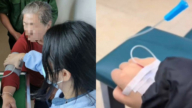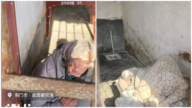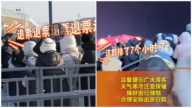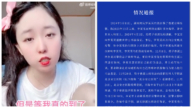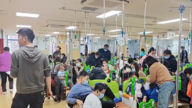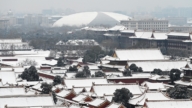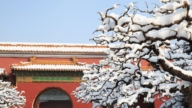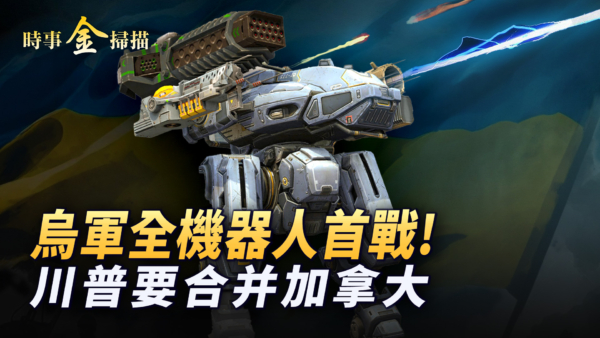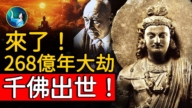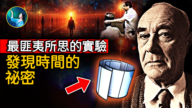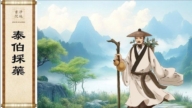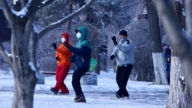【新唐人2013年06月20日讯】由于中国作家巴金对“文革”的忏悔与反省,曾经建议成立“文革博物馆”,以让后人记住这段历史并从中吸取教训。但是,中国第一座文革博物馆直到14年前,在广东省汕头市一个小山头上才悄悄破土动工。它的存在,中共当局从未批准。它的建成,完全依靠前汕头市副市长彭启安。
彭启安从1983年开始担任汕头市副市长,十年内负责了许多大型项目的建设,包括汕头著名的海湾大桥。1996年的某一天,他去位于涂城村的塔山风景区,看到了山坡上一片乱坟。他才得知,这里埋着71位“文革遇难者”。
彭启安突发奇想:能不能建一个纪念性的建筑?他是实干家,立即得到十多名“厅级”老干部和当地老人的支持,成立了“长老院”。涂城村委大多经过“文革”迫害,也很快划出塔山上的土地,让彭启安建设。
在这块占地300亩被称为“塔园”的“文革博物馆”里面,矗立着前中共领导人刘少奇和叶剑英的塑像。对面围栏上刻着“文革”百种酷刑,读来让人不寒而栗。它们背后,是石壁上近万名“文革”死难者的名字。
彭启安告诉《新唐人》,建立“文革博物馆”就是用历史教训后人,千万不要让“中国文化大革命”的悲剧重演。
前汕头市副市长彭启安:“中国自1986年巴金先生提出建立文化大革命博物馆到今天,中国共产党执政者没有表态,没有支持,中国到现在没有一个文化大革命博物馆。你从这里就可以理解,我们塔园文革博物馆,我们一直到现在没有证明,只是民间的活动。得不到国家正式的支持,那你的困难你就可以理解了。”
彭启安表示,他对文革博物馆“不求正名,只求存在”。
彭启安:“既然没有地方接受我们项目批准,就不能……用地不能发展。既然不能发展,就只求存在。我们经过17年社会各个方面的支持,社会民间正义力量的支持,把我们文革博物馆建成8个景区,25个景点。希望现在已经建成的景点能够保存下来,能够存在,所以只求存在。”
2005年,彭启安邀请当时的汕头市委书记,现任广东省委常委林木声参观博物馆。林木声当时表示赞赏,并准备开会给予支持。彭启安以为终于盼到正名的这一天。但是过了一个多月,中央高层派人来调查。
彭启安:“后来上面高层也知道了。他给我们定出的调子是不了了之。就是说,你既然建了,也只能让你存在。但是不要宣传。”
彭启安表示,建设文革博物馆的阻力,主要是中共如何评价毛泽东的问题。因为文化大革命的罪魁就是毛泽东。那么,建立文革博物馆,必然要披露毛泽东的问题。但是中共现在还是维护毛泽东的形象。
彭启安说,他在文化大革命期间被打成走资派,挨过大大小小300多场批斗。虽然建立“文革博物馆”很有压力,但是他已经没有什么可怕的了。因为他的命已经延长多年。
彭启安:“我原来已经被定枪毙,五个人我排第二。后来递到省革委会去,不知道什么原因省革委会没有批。假如有枪毙,是1968年枪毙,到现在44年了。所以我这个老命已经拖后40多年了。”
彭启安呼吁中共,今后不要再搞那些乱七八糟的政治运动。
有人说,今年已经82岁的彭启安如果走了,博物馆也完了。但是彭启安相信,黎明前的黑暗即将过去,曙光终会到来。
采访编辑/秦雪 后制/萧宇
Private Project: China’s First Cultural Revolution Museum
Chinese writer, Ba Jin, has suggested that
the Chinese Communist Party (CCP) authorities
establish a Cultural Revolution museum.
It would enable future generations to remember
the history of this event and to learn from it.
In actual fact, the construction of China’s first museum
didn’t start until 14 years after the Revolution.
It is located on a hilltop in Shantou,
Guangdong province,
The understated project, however, has never been
approved of by the CCP authorities.
It was completed by Peng Qian, Shantou’s ex-vice mayor,
with the aid of the judiciary.
Peng Qian served as vice mayor of Shantou City in 1983.
He took charge of large construction projects
during his ten-year tenure.
In 1996, he was incidentally informed of
the existence of a mound,
in this mound were buried 71 local victims of
the Cultural Revolution.
This inspired Peng to build a monumental building.
His project was supported by over a dozen retired cadres
and by local senior citizens.
The construction site was located on Tashan,
a local hilltop.
The 49-acre Cultural Revolution Museum
was named as “Ta Park".
Inside the building stand the statues of
ex-CCP leaders Liu Shaoqi and Ye Jianying.
Engraved on the opposite stone wall is
an account of 100 kinds of torture,
these tortures were used during Cultural Revolution.
On the back wall are the names of thousands of victims.
Peng Qian says that the Cultural Revolution Museum
was built to educate future generations with historical lessons.
It can remind the public that it mustn’t repeat the mistake
of the tragedy of the Chinese Cultural Revolution.
(Ex-deputy mayor, Shantou) Peng Qian: “Mr. Ba Jin proposed
the setting -up of a Cultural Revolution Museum in 1986.
But over the years,
the CCP has withheld its opinions of this museum.
So until today, China hasn’t had an official museum
of the Cultural Revolution.
That is, our “Ta Park” museum is a purely civil project,
which has never gained official support.
So you can easily imagine the difficulties
we have encountered."
On the museum, Peng Qian doesn’t expect
any formal acknowledgement by the CCP authorities.
He just hopes the museum can continue to exist.
Peng Qian: “The museum project has never
been approved of by any local authorities.
So we cannot develop it, but hope that
they allow it to continue to exist there.
Over the past 17 years, we’ve gained the support
of many local citizens.
Currently, our Cultural Revolution Museum consists of
eight scenic areas with 25 scenic viewpoints.
We just hope that these viewpoints can be left there
as they are now."
In 2005, Peng Qian invited the then Shantou Party chief,
Lin Musheng, to visit the museum.
Lin praised it and intended to hold a meeting to support it.
Peng thought that he would soon receive
official acknowledgement of the project.
However, one month later, he faced investigators
who were sent by CCP central authorities.
Peng Qian:"Later, top-level leadership was
made aware of it.
They finalized the issue by leaving it unsettled.
That is, since you have built the museum,
we acknowledge its existence, but don’t publicize it."
Peng reveals that the main resistance of the project was
centralized in the question of how to evaluate Mao Zedong.
Mao is known as the chief culprit for launching
the Cultural Revolution.
Mao’s crimes would certainly be exposed
in the Cultural Revolution museum.
But up to now, the CCP still maintains Mao’s
established image, according to Peng.
Peng, labeled a “capitalist-roader", has undergone
over 300 pubic accusation assemblies.
He says that he has no fears of building a
Cultural Revolution Museum, though it has it’s worries.
He explains that the project has given him
a new lease of life.
Peng Qian: “At the time, I was the second among
five condemned men on death row.
But unexpectedly, the then provincial authorities
decided against my execution.
Had they decided to execute me,
I would have died 44 years ago, in 1968.
So my life span has actually been extended
for over 40 years."
Peng Qian wants to discourage the CCP from launching
any topsy-turvy political movements again.。
Some people fear that the museum will not be preserved
if 82-year-old Peng Qian passes away.
Yet, Peng himself believes that the pre-dawn darkness
will soon be over, and that eventually dawn will come.


